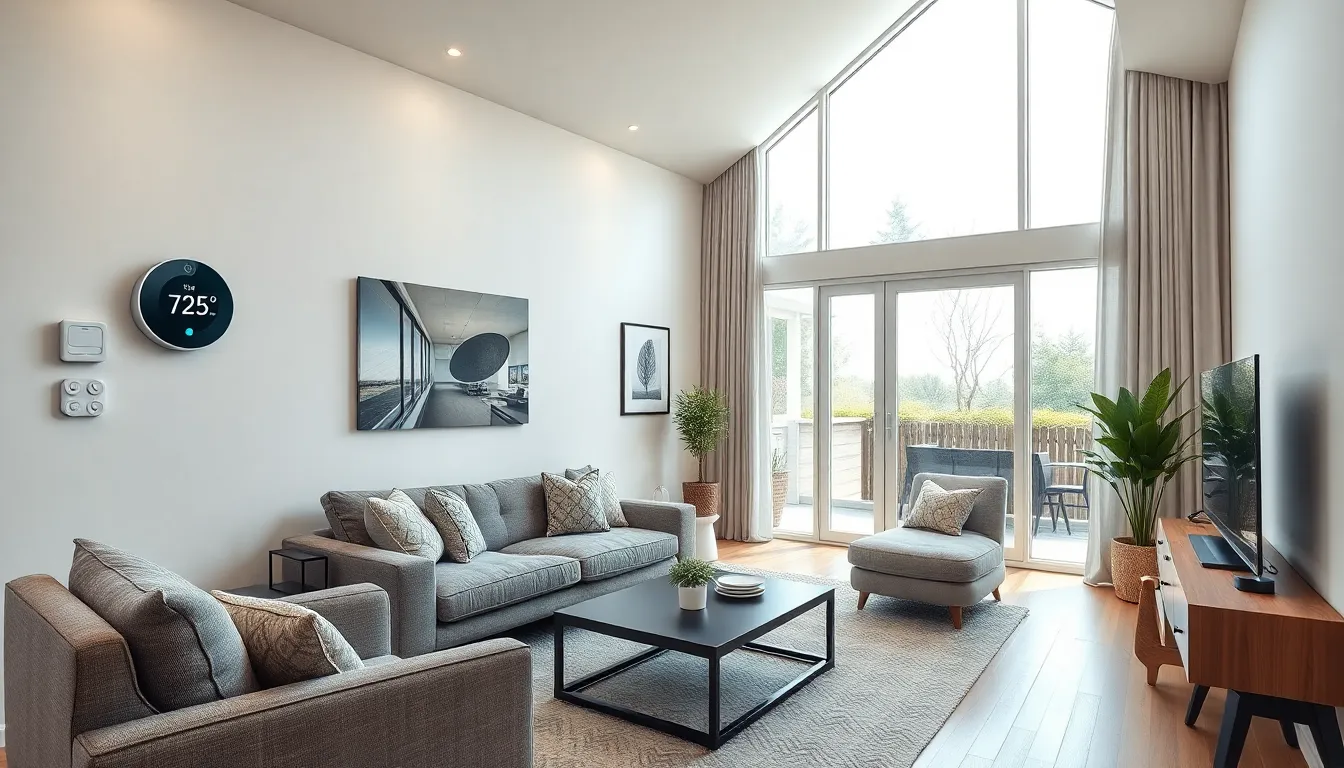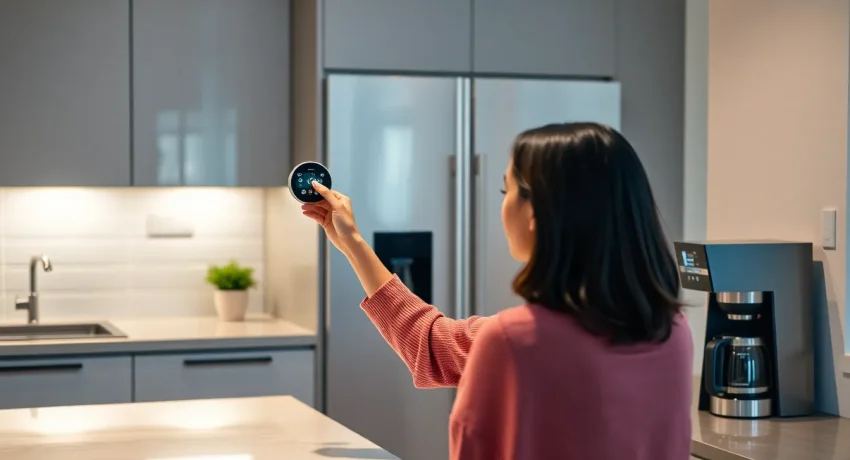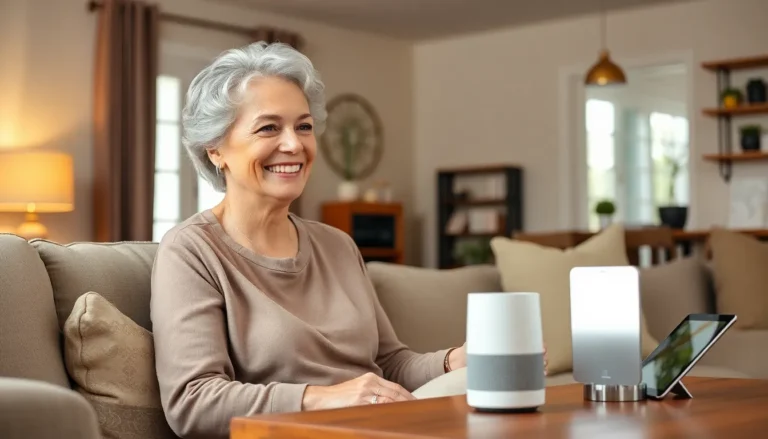Table of Contents
ToggleImagine waking up to a home that knows your preferences, adjusts the temperature, and brews your morning coffee—all before you even step out of bed. The rise of AI-powered homes is transforming the way people live, making everyday tasks more convenient and efficient. With smart devices and intelligent systems working in harmony, homeowners can enjoy a seamless blend of comfort and control.
From energy management to enhanced security, AI technology is revolutionizing domestic life. These innovations not only save time but also offer significant cost savings and improved safety. As more households embrace this technology, the future of living is becoming smarter, more connected, and tailored to individual needs.
Overview of AI-Powered Homes
AI-powered homes integrate intelligent systems and smart devices to optimize daily living. These homes automate routine tasks such as adjusting thermostat settings, managing lighting, and controlling appliances, which enhances comfort and convenience.
Smart devices communicate seamlessly, creating a network that contributes to energy efficiency and security. For example, smart thermostats learn user preferences and adjust temperatures accordingly, leading to energy savings.
Additionally, AI-powered systems provide real-time monitoring, allowing homeowners to track energy consumption and reduce costs. Features such as remote access and voice commands enable users to manage their home environments from anywhere, increasing flexibility in daily routines.
As technology continues to evolve, AI-powered homes are expected to offer even more personalized experiences, making everyday life more efficient and enjoyable.
Benefits of AI-Powered Homes

AI-powered homes offer various advantages that transform daily living. The integration of intelligent systems enhances security, improves energy efficiency, and elevates overall convenience.
Enhanced Security Features
AI-powered homes incorporate advanced security measures to protect users. Smart cameras provide real-time surveillance, enabling users to monitor their property remotely. Alarm systems leverage AI algorithms to distinguish between normal activities and potential threats, reducing false alarms. Home automation grants users the ability to lock doors or control lights from anywhere. In case of breaches, notifications alert homeowners immediately, allowing swift responses to intrusions. These features create a safer living environment and increase peace of mind.
Energy Efficiency Improvements
AI-powered homes significantly enhance energy efficiency by optimizing energy consumption. Smart thermostats adjust settings based on user habits and preferences, minimizing waste. Automated lighting systems enable users to control lights remotely or set schedules, ensuring lights are off when not needed. Smart appliances, like refrigerators and HVAC units, give real-time data on energy usage, helping homeowners identify and reduce unnecessary costs. Through improved efficiency, AI-powered homes contribute to lower utility bills and a reduced carbon footprint.
Popular AI Technologies in Smart Homes
AI technologies enhance the functionality of smart homes, driving convenience and efficiency. Several key technologies play vital roles in this automation ecosystem.
Voice Assistants
Voice assistants, such as Amazon Alexa, Google Assistant, and Apple Siri, enable hands-free control of smart devices. These platforms recognize natural language commands, allowing users to manage various tasks, from adjusting lights to playing music. Voice assistants integrate with multiple devices, creating a unified home automation system. They respond to queries, control home security systems, and operate appliances, significantly streamlining daily activities. The utilization of voice recognition technology has transformed user interactions with devices, promoting efficiency and ease of use.
Smart Thermostats
Smart thermostats, like Nest and Ecobee, learn user preferences and adjust heating and cooling settings accordingly. They utilize sensors to detect occupancy, optimizing energy consumption based on comfort and efficiency. These devices allow remote temperature control through mobile apps, making it easy for homeowners to manage their environments from anywhere. With capabilities like scheduling and energy reports, smart thermostats help reduce energy bills and carbon footprints. Over time, they contribute to improved home energy management, presenting analytics that inform users about their energy use patterns.
Challenges and Considerations
Despite the advantages of AI-powered homes, several challenges and considerations arise that warrant attention. Addressing these issues ensures optimal utilization and security of smart technology in domestic settings.
Privacy Concerns
Privacy concerns remain a critical challenge in AI-powered homes. Smart devices often collect vast amounts of personal data, including usage habits and preferences. Unauthorized access to this data can lead to significant privacy violations. For example, smart cameras and voice assistants can potentially record conversations and activities. Homeowners should prioritize data security by utilizing strong passwords, enabling two-factor authentication, and regularly updating device firmware. Understanding privacy policies from device manufacturers also helps users make informed decisions regarding data sharing and protection.
Dependence on Technology
Dependence on technology poses another significant consideration. Increased reliance on AI systems may lead to reduced human skills in household management and decision-making. Over time, individuals may struggle to navigate basic tasks without technological assistance. Additionally, system failures or outages can disrupt daily routines and create vulnerability. Ensuring a balance between technology and traditional methods fosters resilience in managing home environments. Homeowners should maintain manual controls and familiarize themselves with essential functions of their devices, mitigating reliance on automated systems during emergencies or failures.
Future Trends in AI-Powered Homes
AI-powered homes are evolving rapidly, integrating smarter technologies to enhance user experiences. Emerging trends include advanced interoperability among devices and enhanced predictive analytics, allowing systems to anticipate residents’ needs.
Integration of IoT Devices
Integration of Internet of Things (IoT) devices facilitates seamless communication. Devices such as smart refrigerators, washers, and smoke detectors communicate with a central hub, leading to cohesive home management. Homeowners benefit from coordinated actions based on predefined scenarios, improving convenience.
Voice-Activated Automation
Voice-activated automation continues to gain traction. Users interact with home systems through natural language commands, enhancing accessibility for all age groups. Smart speakers equipped with AI assistants like Google Assistant and Amazon Alexa can control lighting, heating, and even order groceries, streamlining daily tasks.
Enhanced Security Features
Enhanced security features are a priority for future AI-powered homes. Next-generation smart surveillance cameras utilize facial recognition and anomaly detection to improve safety. These systems alert homeowners to potential threats in real time and integrate with emergency services for quicker response times.
Energy Management Innovations
Energy management innovations are critical to addressing sustainability. AI algorithms analyze usage patterns, optimizing energy consumption and reducing costs. Smart grids communicate with home systems to adjust power usage during peak times, further decreasing carbon footprints.
Personalized User Experiences
Personalized user experiences represent a significant trend. AI learns individual habits to customize home environments, adjusting lighting, temperature, and entertainment options automatically. This tailored approach enhances comfort and aligns with user preferences.
Sustainability Focus
Sustainability focus shapes future developments. AI technologies manage energy efficiently, monitoring usage and integrating renewable energy sources into homes. Solar panels and energy storage systems paired with AI optimize energy flow, enabling homes to become self-sufficient.
Health and Wellness Integration
Health and wellness integration brings new opportunities. Wearable devices connect with home systems to monitor health metrics. Smart air purifiers and humidity controllers create optimal living conditions, improving overall well-being and indoor air quality.
These trends show a clear trajectory toward smarter, safer, and more efficient living environments. Advancements in AI technology continue to redefine what is possible in home automation and management.
AI-powered homes represent a significant leap forward in how individuals interact with their living spaces. By integrating smart technologies and automation, these homes not only enhance convenience but also promote energy efficiency and security. As advancements continue to emerge, homeowners can expect even greater integration and personalization tailored to their needs.
While the benefits are substantial, it’s crucial to remain mindful of privacy concerns and the potential challenges that come with increased reliance on technology. Striking a balance between innovation and traditional methods will ensure a resilient approach to home management. As the future unfolds, the possibilities for smarter, safer, and more sustainable living environments are boundless.




